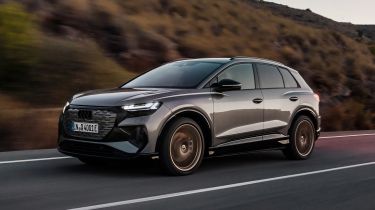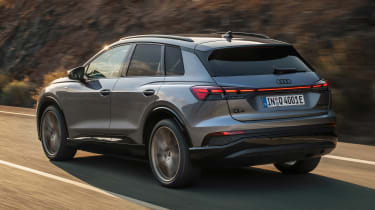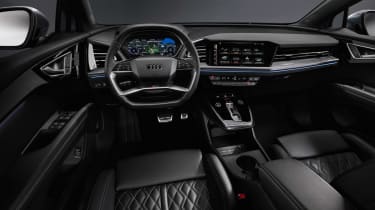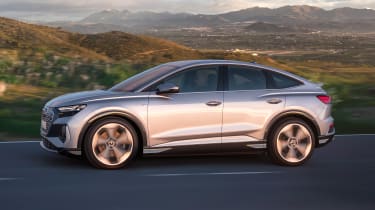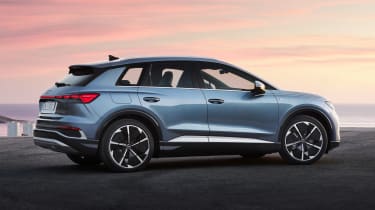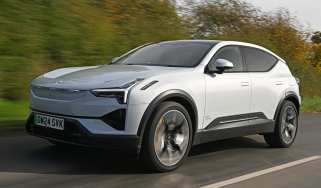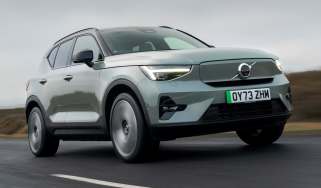Audi Q4 e-tron updated for 2022
The Audi Q4 e-tron SUV and Q4 e-tron Sportback EVs get faster charging and extra connectivity
- Audi Q4 e-tron available as a regular SUV and Sportback
- Uses same platform as ID.4 SUV
- 315-mile range
The Audi Q4 e-tron line-up has received a minor update for 2022. The changes to Audi’s smallest EV include faster charging capability and new connectivity technology, and apply to both the Q4 e-tron SUV and Q4 Sportback e-tron models.
Audi has boosted the maximum charging speeds for the larger 77kWh battery versions, raising it from 125kW to 135kW. While this change may sound small, the brand claims it reduces the 5-80% charging time from 38 to 29 minutes in the 40 e-tron model, while the top up time for 50 e-tron is reduced from 38 to 36 minutes.
 The 10 best electric cars in 2025
The 10 best electric cars in 2025
The Q4 range also gets extra connectivity, with Amazon Alexa now integrated within the infotainment system. This allows owners to use voice commands to access their calendar and shopping list as they drive, along with controlling linked smart home devices such as garage door openers and outdoor connected lights. It adds remote app functionality, too, including where the car is parked and the current status of the battery.
The Q4 e-tron the first Audi production model to use the VW Group’s MEB platform, which is shared with the Volkswagen ID.4 SUV and Skoda Enyaq iV. Other close rivals will include the Mercedes EQA, Ford Mustang Mach-E and the Tesla Model Y.
2021 Audi Q4 e-tron: design and practicality
Audi has carried over a number of design cues from the original Q4 e-tron concept car. The front end sports the firm’s signature SUV design with slightly raised bonnet and a pair of slim LED headlights, which will be upgradable to Matrix LEDs as an option. The hexagonal front grille is closed off to aid efficiency, with slats that open when cooler air is required. The grille features a prominent piece of trim around the edge, which is similar to the Q8 SUV. Contrasting bodywork cladding features in the lower parts of the bumpers and wheel arches. At the sides, the front and rear wings boast a sharp cut-line, which makes the car look wider. Beneath this are a pair of angular lines running across the doors and lower sills. Small Audi logos are featured on the rear quarter panel. The rear of the car gets an intricate tail-light design, similar to the e-tron GT sports car, and a rear diffuser.
As is common across the entire Audi range, buyers will be able to choose contrasting silver trim around the grille, window surrounds and badges. A Black Edition model will swap that for black trim. A range of 19 to 21-inch alloy wheels will be available across the Q4 e-tron line-up.
In standard SUV guise, the Q4 e-tron’s roofline is angled downward from the B-pillar onwards, giving it a similar side profile to the ID.4 SUV. The Sportback model has a more dramatically angled roofline, giving it the familiar coupe-SUV look. Other changes for the Sportback include a raised rear spoiler at the base of the rear windscreen running between the C-pillars.
The car’s electric drivetrain and MEB platform aids practicality. In the standard Q4 e-tron, there’s a 520-litre boot with the 40:20:20 split-folding rear seats upright, which expands to 1,490 litres when folded down. The Sportback offers slightly more storage space, with 535 litres available with the rear seats upright, which expands to 1,460 litres when folded flat.
Interior and technology
The interior of the Q4 e-tron takes design cues from the latest A3, with Audi claiming that it’s as spacious inside as the Q5 SUV thanks to the packaging of the electric powertrain.
The dashboard features an angular design, with a continuous lip across the centre to separate the upper and lower sections. The hexagonal steering wheel features touch sensitive controls with haptic feedback. Audi’s Virtual Cockpit digital dial cluster also features, with a 10.25-inch panel as standard and a larger 12.3-inch version on the options list. This is complemented by a standard 10.1-inch infotainment touchscreen in the centre of the dashboard, which features an enhanced sat nav system and a route planner that can add charging points on longer journeys. An upgraded 11.6-inch infotainment touchscreen will be available after launch.
A floating centre console houses the car's gear shifter, as well as providing a storage space beneath it. An array of storage cubbies are dotted around the interior as well, including a large centre console bin and bottle holders in the front door panels.
New technology includes an augmented reality head-up display. This is capable of showing sat-nav directions around 10 metres in front of the car as you drive, which are only visible from the driver’s perspective.
While full specifications of UK models have yet to be fully confirmed, a variety of safety technology is likely to be available, including collision assist, lane keep assist, traffic sign recognition and adaptive cruise control.
UK buyers will also be able to pick from several interior trim options, ranging from real leather upholstery and Nappa leather to a man-made faux leather option. You can also expect various contrasting trim options including piano black and carbon-fibre effect inserts and ambient interior lighting.
Performance, powertrain and charging
The Q4 e-tron SUV uses the VW Group’s dedicated MEB platform for electric cars, just like the Volkswagen ID.3 hatchback and the ID.4 SUV. This chassis keeps the batteries and electric motors low for improved dynamics and handling.
The Q4 35 e-tron kicks off the range with a rear-mounted electric motor producing 168bhp and a 52kWh battery. This powertrain is capable of 0-62mph in nine seconds and a range of up to 209 miles for the regular SUV model.
The Q4 40 e-tron features a more powerful 201bhp electric motor, making it slightly quicker; 0-62mph takes 8.5 seconds and top speed is 99mph. It boasts a larger 77kWh battery, resulting in a significantly larger range figure of up to 315 miles for the regular SUV.
The flagship Q4 50 e-tron quattro uses the same 77kWh battery as the midrange model but gets an electric motor on the front axle as well as one on the rear, making it four-wheel drive. Power is increased to 295bhp and it manages 0-62mph in only 6.2 seconds, with a top speed of 112mph. In spite of the increased power and performance, the 50 e-tron manages up to 300 miles of range.
As part of the early 2022 update, both the 40 and 50 e-tron can be fast charged at a maximum charging rate of 135kW, with Audi claiming a ten-minute charge adds just over 80 miles of range. Both models are also compatible with 11kW AC wallbox chargers.
Every Q4 e-tron features six selectable drive modes including ‘comfort’ and ‘auto’ for normal driving. An ‘individual’ mode allows drivers to personalise the car’s setup, with ‘dynamic’ mode sharpening the chassis and throttle response. Also featured are a pair of battery optimisation modes designed for eking out as much range as possible, with ‘range’ limiting the top speed to 55mph, which is raised to 80mph in the ‘efficiency’ setting.
Trim levels and prices
Audi has confirmed the Q4 e-tron will be available in four trim levels including an exclusive Edition 1 launch model for the first year of production.
The range kicks off with the Sport trim, which has 19-inch alloy wheels finished in graphite grey. It also has contrasting grey exterior trim, gloss window surrounds and LED headlights. Prices for the Sport model start from £43,115.
S line models get additional sporty features with alternative front and rear bumpers, chrome exterior trim, rear privacy glass and 20-inch alloy wheels. The interior features ‘S’ logos throughout, as well as illuminated door sills, a black headliner, a leather-trimmed steering wheel, and cloth and faux leather-trimmed seats. Prices for the S line trim start from £45,215.
A special Edition 1 trim is available priced from £48,735. This model piles on the standard kit, adding Matrix LED headlights, a black exterior styling package and sports suspension, with the latter lowering the ride height by 15mm. Inside, a new hexagonal steering is fitted with shift paddles, which are used to switch between the battery regen modes.
The range-topping Vorsprung adds larger 21-inch alloy wheels and a panoramic sunroof to the standard black contrasting exterior trim. Interior upgrades include Nappa leather-trimmed seats, along with wireless smartphone connectivity and charging, and a Sonos premium stereo system. It also gets an enhanced version of Audi’s Virtual Cockpit digital dial setup, adding a specific e-tron graphics. Standard safety kit includes the Safety Package Plus, which adds side assist, blind spot monitoring and a rear cross traffic reversing aid. The flagship Vorsprung model starts at £56,240.
Read our guide to the best electric SUVs on the market.
Recommended
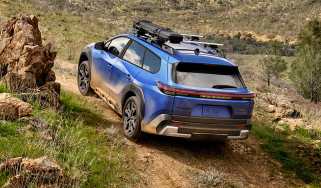
New Subaru Trailseeker revealed as rugged electric SUV with 375bhp
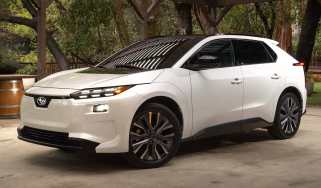
New Subaru Solterra brings more range, power and polish
Most Popular
Tips & advice

Car dashboard warning lights: what does each symbol mean?

Electric car charging stations: public networks, charger types, apps and maps


